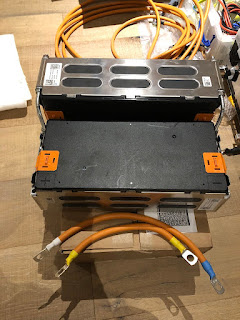Electric conversion for my Fiat 500 – day 10
Today was about fitting a shunt and the reverse lever to get the pedal to command the throttle.
The shunt is used as extra safety device and to measure the Voltage and use of Current in the system. The kit I've installed didn't include one and you don't have to have one, but I just thought extra point of safety would not harm. Plus this will give me an indicator of power consumption.
The reverse lever is just a simple lever that extends the pull from the run that the pedal allows to the required run that the Curtis PB-6 potentiometer / throttle would require. It also helps me use the original pedal throttle and pull cable of the Fiat 500. If I wanted to get the original motor back on it would be just very easy as all these bits will be there in position.
Fitting the shunt
STEP 90
Untie the connection to the battery on the - minus pole. And connect the battery - to the bolt marked as B- or battery in the shunt.
STEP 91
Connect the other end of the cable going to the load (the motor or actually the contactor first) to the other bolt in the contactor. This is clearly marked as To the Load, so you can not really miss it.
Step 92
Now you need to power the shunt up and for this you need to connect the small red (in my case) wire to the + positive of the battery. Note that this wire has got also a 3 amp small fuse.
Be careful handling this wire because it may cause and probably will make a spark at some point.
Please do wear insulating gloves for this operation.
The other end of the wire terminating with a pin needs to be plugged in the shunt. There is only one socket hole in my shunt model.
Step 93
Connect the UTP cable to the shunt at one end and to the Monitor dial at the other end. The monitor at this point will light up.
This connection cable has RJ12 plugs at both ends.
Moving on to fit the reverse lever.
In my case this is a custom component that I have designed and built at the hackspace where I go.
It may be useful to you to know that the small arm measure 35 mm as lever axel points. While the long lever is 75 mm from axial point to axial point.
Pulling the small arm will move the longer arm of a greater length so the small pedal movement will be amplified to pull the Curtis PB-6 potentiometer.
For now I wont document the steps for this component as the pictures and video are self explanatory.







Comments
Post a Comment